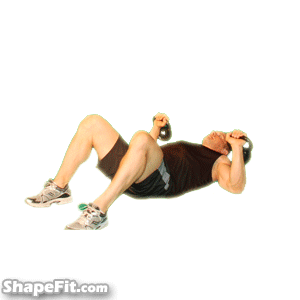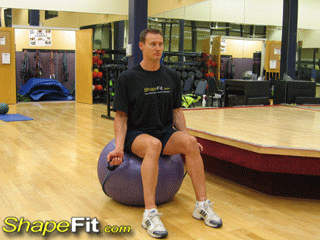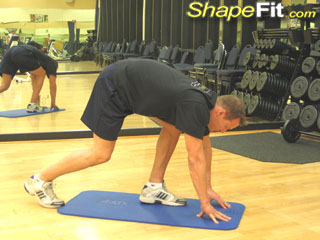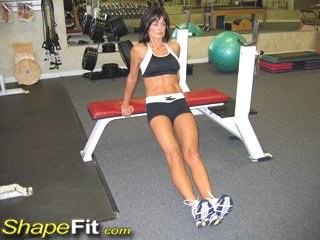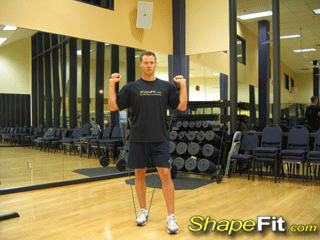Barbell Lunges – Quadriceps Exercise Guide with Photos
The barbell lunge is the pumped up version of the bodyweight lunge. This exercise can greatly increase the strength in your legs while developing balance and flexibility in your hips. Using this exercise is a great way to correct any imbalances that can occur from favoring one leg over another. If you’ve thought the lunge was beneath you, load up a barbell and give these bad boys a shot.
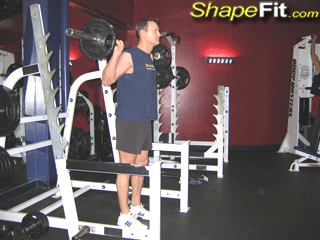
Muscles Targeted: The lunge directly targets your quadriceps and your gluteus maximus. It also puts stress on the adductor and abductor muscles which are responsible for moving your thigh inwards or outwards. Indirectly your erector spinae and core muscles are engaged to stabilize your upper body while moving downwards. The balance required to perform these also calls your calf muscles into play.
Exercise Instructions: Place a barbell behind your neck and rest it across your shoulders. Be sure that you have enough room to perform this exercise. Begin by striding forward with one leg to execute a regular lunge while keeping the other leg set in place. Be sure to really stride forward so that you get a great stretch. Bring that leg back to the start position and repeat with the opposite leg.
Why This Exercise is Important: Barbell lunges are important to use in your routine so you can correct any imbalances that have occurred from using one leg over the other. This can occur from using bad technique while weightlifting, or even from athletic events or just daily life. These imbalances can cause you to use poor technique while working out your legs and open your body up to an increased chance of injury. Barbell lunges are also great to promote balance and flexibility in your lower legs and hips. Our daily life does not promote flexibility in your lower legs and barbell lunges are a great way to use ranges of motion that are not typically used. The lunge also builds strength in an unstable environment which can lead to carryover in your daily life or athletic events that call for you to generate force off one leg.
Things To Avoid: When doing barbell lunges you want to be careful to avoid losing your balance. You could fall over and hurt your lower back or knees and even your shoulders from holding the weight incorrectly. It’s a good idea to do these in a squat rack just in case you need some additional support. Make sure that you don’t allow your knee to travel too far over the front of your foot to keep unnecessary stress off the knees. Also keep your knees from moving too much to one side or the other. Don’t let your supporting leg’s knee hit the ground hard when going down. Always keep your back arched and keep a firm grip on the bar to prevent it from sliding around on you.
Reps and Sets: Barbell lunges are a great exercise to use for higher repetitions. The unstable nature of the movement makes it difficult to load up and really go heavy since this can quickly encourage a breakdown in form. Try barbell lunges out in sets of 1-3 and repetitions from 12-15. This will allow you to fatigue the muscles without your balance coming too much into play. These are great as a finisher to a routine or as a pre-exhaust before you move onto heavier movements.
Other Exercises To Use: You can use several other movements in place of barbell lunges. Barbell squats are a two-legged version of lunges and complement them well. Consider using front squats as well for their emphasis on the quadriceps. Barbell deadlifts also use much of the same muscles, but in a different movement plane and can serve as a great substitute. View our extensive database of exercise guides for a comprehensive list of all the exercises that target the quadriceps.
Remember, barbell lunges can be used to prevent or rehabilitate any muscular imbalances that have occurred in your legs. They are also a great way to get some real world carryover from your strength routine. Give these a go at the beginning or end of your routine and make sure that you have a squat rack nearby when first learning the movement.
-
Hip Flexor – Stretching Exercise Guide with Photos
Exercise Advice: This stretch is very similar to a bas
-
Standing Towel Extension – Triceps Exercise Guide
Exercise Advice: While standing, hold a towel with bot
-
Side Lateral Deltoid Raise with Bands – Exercise Ball Guide
Exercise Advice: Sit on an exercise ball with your bac
-
Seated Hurdler Stretch – Stretching Exercise Guide with Photos
Exercise Advice: Sit on a mat on the floor with one le
-
Exercise As A Lifestyle
You don’t need to purchase expensive in-home exercise equipment
-
Lying T-Bar Rows – Back Exercise Guide with Photos
Muscles Targeted: Lying T-bar rows mainly target the m
- DON'T MISS
- Elevated Leg Curl Up – Core Exercise Guide with Photos
- Criss Cross with Legs – Pilates Exercise Guide with Photos
- Lying Barbell Extensions – Triceps Exercise Guide with Photos
- Abdominal Sit Ups – Abs Exercise Guide with Photos
- Make The Most Of Your Vegetables
- One Arm Biceps Curls – Elastic Bands Exercise Guide
- Core Training Exercise Guides with Instructions and Photos
- Bent Over Rear Deltoid Raises – Elastic Bands Exercise Guide
- One Arm Triceps Kickbacks – Elastic Bands Exercise Guide
- Seated Tricep Extensions – Kettlebell Exercise Guide with Photos
